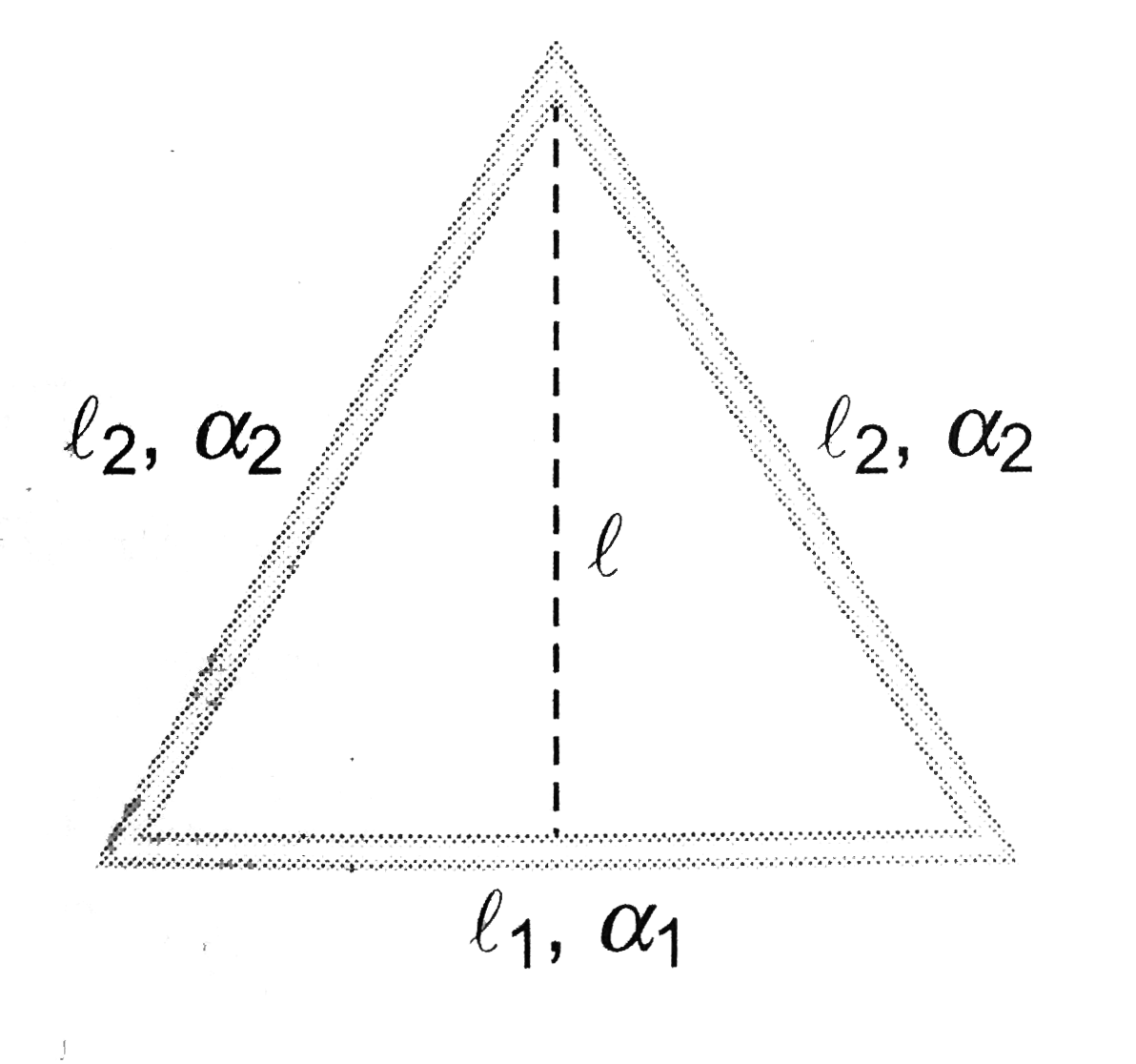Two rods of length l1 and l2 are made of material whose coefficient of linear expansion are α1 and α2 , respectively. The difference between their lengths will be independent of temperatiure if l1/l2 is to
L1L2=α1α2
L1L2=α2α1
L22α1=L21α
α21L1=α22L2
The correct Answer is:D
To solve the problem, we need to analyze the change in lengths of the two rods due to temperature variation. The change in length of a rod due to thermal expansion can be expressed using the formula:
ΔL=L0⋅α⋅ΔT
where:
- ΔL is the change in length,
- L0 is the original length of the rod,
- α is the coefficient of linear expansion, and
- ΔT is the change in temperature.
For the two rods, we can denote the changes in length as follows:
1. For the first rod of length l1 with coefficient of linear expansion α1:
ΔL1=l1⋅α1⋅ΔT
2. For the second rod of length l2 with coefficient of linear expansion α2:
ΔL2=l2⋅α2⋅ΔT
We are interested in the difference in lengths of the two rods after the temperature change, which is given by:
ΔL=ΔL1−ΔL2
Substituting the expressions for ΔL1 and ΔL2:
ΔL=(l1⋅α1⋅ΔT)−(l2⋅α2⋅ΔT)
Factoring out ΔT:
ΔL=ΔT⋅(l1⋅α1−l2⋅α2)
For the difference in lengths to be independent of temperature, ΔL must be zero. This leads to the condition:
l1⋅α1−l2⋅α2=0
Rearranging this gives:
l1⋅α1=l2⋅α2
Dividing both sides by l2⋅α1:
l1l2=α2α1
Thus, we find that the ratio of the lengths l1 and l2 is given by:
l1l2=α2α1
This means that for the difference in lengths to be independent of temperature, the ratio of the lengths of the two rods must be equal to the ratio of their coefficients of linear expansion.
Final Answer:
l1l2=α2α1
---
- ΔL is the change in length,
- L0 is the original length of the rod,
- α is the coefficient of linear expansion, and
- ΔT is the change in temperature.
ΔL1=l1⋅α1⋅ΔT
ΔL2=l2⋅α2⋅ΔT
l1l2=α2α1
Topper's Solved these Questions
- THERMOMETRY THERMAL EXPANSION AND KINETIC THEORY OF GASESBOOK - DC PANDEY ENGLISHCHAPTER - THERMOMETRY THERMAL EXPANSION AND KINETIC THEORY OF GASESEXERCISE - Check point 14.3
20 Videos
- THERMOMETRY THERMAL EXPANSION AND KINETIC THEORY OF GASESBOOK - DC PANDEY ENGLISHCHAPTER - THERMOMETRY THERMAL EXPANSION AND KINETIC THEORY OF GASESEXERCISE - Check point 14.4
25 Videos
- THERMOMETRY THERMAL EXPANSION AND KINETIC THEORY OF GASESBOOK - DC PANDEY ENGLISHCHAPTER - THERMOMETRY THERMAL EXPANSION AND KINETIC THEORY OF GASESEXERCISE - Check point 14.1
10 Videos
- SUPERPOSITION OF WAVESBOOK - DC PANDEY ENGLISHCHAPTER - SUPERPOSITION OF WAVESEXERCISE - Level 2 Subjective
8 Videos
- THERMOMETRY,THERMAL EXPANSION & KINETIC THEORY OF GASESBOOK - DC PANDEY ENGLISHCHAPTER - THERMOMETRY,THERMAL EXPANSION & KINETIC THEORY OF GASESEXERCISE - Level 2 Subjective
9 Videos
Similar Questions
Two rods of lengths l1andl2 are made of materials having coefficients of linear expansion α1andα2 respectively. What could be the relation between above values, if the difference in the lengths of the two rods does not depends on temperature variation?
View SolutionThere are two rods of length l1 and l2 and coefficient of linear expansions are α1 and α2 respectively.
Find equivalent coefficient of thermal expansion for their combination in series.
View SolutionTwo rods having length l1 and l2, made of materials with the linear coefficient of expansion α1 and α2 were welded together. The equivalent coefficients of linear expansion for the obtained rod:-

View SolutionSTATEMENT - 1 : A metallic rod placed upon smooth surface is heated. The strain produced is ZERO.
STATEMENT - 2 : Strain is non-zero only when stress is developed in the rod.
STATEMENT - 3 : Two metallic rods of length l1 and l2 and coefficient of linear expansion α1 and α2 are heated such that the difference of their length ramains same at ALL termperatures Then α1α2=l2l1
View SolutionThe length of two metallic rods at temperatures θ are LA and LB and their linear coefficient of expansion are αA and αB respectively. If the difference in their lengths is to remian constant at any temperature then
View SolutionTwo metallic rods of length l and 3l have coefficient of linear expansion α and 3α respectively. The coefficient of linear expansion ofr their series combinations, is
View SolutionAn isosceles triangles is formed with a thin rod of length l1 and coefficient of linear expansion α1, as the base and two thin rods each of length l2 and coefficient of linear expansion α2 as the two sides. The distance between the apex and the midpoint of the base remain unchanged as the temperature is varied. the ratio of lengths l1l2 is

View SolutionAn isosceles triangles is formed with a thin rod of length l1 and coefficient of linear expansion α1, as the base and two thin rods each of length l2 and coefficient of linear expansion α2 as the two sides. The distance between the apex and the midpoint of the base remain unchanged as the temperature is varied. the ratio of lengths l1l2 is

View SolutionAn isosceles triangles is formed with a thin rod of length l1 and coefficient of linear expansion α1, as the base and two thin rods each of length l2 and coefficient of linear expansion α2 as the two sides. The distance between the apex and the midpoint of the base remain unchanged as the temperature is varied. the ratio of lengths l1l2 is

View SolutionTwo different wires having lengths L1 and L2 and respective temperature coefficient of linear expansion α1 and α2 are joined end - to - end . Then the effective temperature coefficient of linear expansion is :
View Solution
